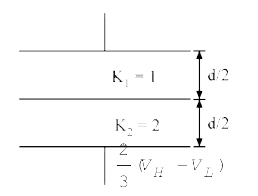The amplification factor of a triode is 50. If the grid potential is decreased by 0.20 V, what increase, in plate potential will keep the plate current unchanged ?
5 V
10 V
0.2 V
50 V
The correct Answer is:B
To solve the problem step by step, we will use the concept of the amplification factor (μ) of a triode. Here’s how we can approach it:
1. Understand the Given Values:
- The amplification factor (μ) of the triode is given as 50.
- The decrease in grid potential (ΔVg) is given as -0.20 V (since it is a decrease).
2. Recall the Formula for Amplification Factor:
- The amplification factor (μ) is defined as:
μ=ΔVpΔVg
where:
- ΔVp = change in plate potential
- ΔVg = change in grid potential
3. Rearranging the Formula:
- To find the change in plate potential (ΔVp), we can rearrange the formula:
ΔVp=μ×ΔVg
4. Substituting the Values:
- Now, substitute the known values into the equation:
ΔVp=50×(−0.20V)
5. Calculating ΔVp:
- Perform the multiplication:
ΔVp=50×−0.20=−10V
- Since we are looking for an increase in plate potential to keep the plate current unchanged, we take the absolute value:
ΔVp=10V
6. Conclusion:
- Therefore, the increase in plate potential required to keep the plate current unchanged is 10 V.
Final Answer:
The increase in plate potential required is 10 V.
---
- The amplification factor (μ) of the triode is given as 50.
- The decrease in grid potential (ΔVg) is given as -0.20 V (since it is a decrease).
- The amplification factor (μ) is defined as:
μ=ΔVpΔVg
where:
- ΔVp = change in plate potential
- ΔVg = change in grid potential
- To find the change in plate potential (ΔVp), we can rearrange the formula:
ΔVp=μ×ΔVg
- Now, substitute the known values into the equation:
ΔVp=50×(−0.20V)
- Perform the multiplication:
ΔVp=50×−0.20=−10V
- Since we are looking for an increase in plate potential to keep the plate current unchanged, we take the absolute value:
ΔVp=10V
- Therefore, the increase in plate potential required to keep the plate current unchanged is 10 V.
The increase in plate potential required is 10 V.
Similar Questions
In a photoelectric experiment anode potential is ploted against plate current.

View SolutionCalculate the amplification factor of a triode valve which has plate resistance of 2kΩ and transconductance of 2 millimho.
View SolutionGravitational potential at point 'P' due to triangular plate is V0 . Find the gravitational potential due to the given plate at point 'Q' as shown in figure. (both plates are made by same meterial)
View SolutionWhen the current in a certain inductor coil is 5.0A and is increasing at the rate of 10.0A/s,the magnitude of potential difference across the coil is 140V.When the current is 5.0A and decreasing at the rate of 10.0A/s,the potential difference is 60V.The self inductance of the coil is :
View SolutionFigure 33.5 depicts the grid characteristics of a triode plotted at anode voltages of 450 V and 600 V. Find the triode's internal resistance Ri in the linear section of the characteristic and its amplification factor μ, i.e. the ration of the change in the anonde voltage to the change in the grid voltage which cauases a given change in the anode current.
View SolutionA capacitor charged to 50V is discharged by connecting the two plates at t=0.If the potential difference across the plates drops to 1.0 V at t=10 ms,what will be the potential difference at t=20 ms?
View SolutionThe plates of a parallel plate capacitor are charged to a potential difference of 117 V and then connected across a resistor. The potential difference across the capacitor decreases exponentially with to time.After 1s the potential difference between the plates is 39 V, then after 2s from the start, the potential difference (in V) between the plates is
View SolutionA pararllel plate capacitor has plates of area A and separation d and is charged to potential diference V. The charging battery is then disconnected and the plates are pulle apart until their separation is 2d. What is the work required to separate the plates?
View SolutionA parallel plate capacitor of plate area A and plates separation distance d is charged by applying a potential V0 between the plates. The dielectric constant of the medium between the plates is K. What is the uniform electric field E between the plates of the capacitor ?
View SolutionTwo dielectric slabs of area of cross-section same as the area of the plates are introduced inside a capacitor as shown. Now, the capacitor is charged. If the potential of the upper plate of the capacitor is
VH and the potential of the lower plate is VL, the potential at the interface of the two slabs is:

View Solution
